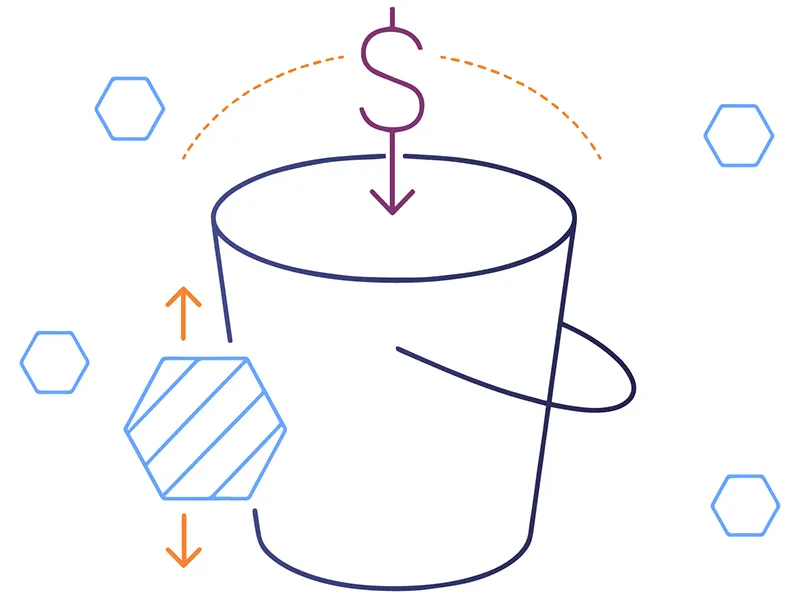O Amazon S3 Intelligent-Tiering é uma das maneiras mais eficazes de reduzir os custos de armazenamento em nuvem, especialmente ao lidar com padrões imprevisíveis de acesso a dados. Na Hystax, ajudamos as equipes de TI a otimizar os gastos com nuvem. Este guia mostra como Amazon S3 Intelligent Tiering funciona e como usá-lo de forma eficaz para cortar custos sem comprometer a disponibilidade ou o desempenho dos dados.

O que é o Amazon S3 Intelligent-Tiering?
O Amazon S3 Intelligent Tiering é uma classe de armazenamento que move dados automaticamente entre diferentes níveis de acesso com base no uso. Ele foi projetado para dados com padrões de acesso desconhecidos ou variáveis. Você não precisa prever a frequência com que os dados serão acessados — o S3 faz isso por você e cobra de acordo.
Não há taxas de recuperação e a transição entre níveis ocorre automaticamente nos bastidores. O objetivo é armazenar seus dados da maneira mais econômica possível, sem esforço manual.
Camadas de armazenamento no S3 Intelligent-Tiering
O Amazon S3 Intelligent Tiering consiste em vários níveis de acesso:
- Nível de Acesso Frequente – Para dados acessados com frequência. Este é o nível padrão quando um objeto é carregado pela primeira vez.
- Nível de acesso pouco frequente: este nível oferece um custo de armazenamento menor para dados não acessados por 30 dias consecutivos.
- Nível de acesso instantâneo ao arquivo: este nível é ainda mais barato, mas ainda está disponível instantaneamente para dados não acessados em 90 dias.
- Acesso opcional ao arquivo e níveis de arquivo profundo – oferecem os preços mais baixos, mas exigem tempos de restauração de minutos a horas.
Esta hierarquização permite que a AWS otimize os custos de armazenamento com base em como os dados são usados ao longo do tempo.
Benefícios do uso do Intelligent-Tiering
Economia de custos
Sem taxas de recuperação
Ao contrário do S3 Glacier, o Intelligent-Tiering não cobra pela recuperação de dados.
Otimização automática
A AWS monitora seus dados e os transfere entre camadas sem nenhum trabalho manual.
Desempenho perfeito
Os dados em todas as camadas (exceto as de arquivo opcional) são instantaneamente acessíveis, sem atrasos de desempenho.
Quer ver quanto você pode economizar com o Intelligent-Tiering
e outras técnicas de otimização?
Insira seu e-mail comercial para explorar os recursos do OptScale como uma plataforma FinOps
Obrigado pelo seu pedido!
Entraremos em contato em breve.
Respeitamos a sua privacidade. Veja a nossa política de Privacidade. Você pode cancelar a assinatura a qualquer momento.

Otimização gratuita de custos de nuvem e gerenciamento aprimorado de recursos de ML/IA para toda a vida
Quando usar o S3 Intelligent-Tiering

Como habilitar o S3 Intelligent-Tiering
Você pode usar o Intelligent-Tiering de algumas maneiras:
1. Defina como padrão durante o upload
Ao carregar dados no Amazon S3, use o Console, a CLI ou a API da AWS para escolher Intelligent Tiering como a classe de armazenamento.
2. Use políticas de ciclo de vida
Já armazena dados em outras classes? Você pode criar regras de ciclo de vida que fazem a transição automática de objetos para camadas inteligentes após um determinado número de dias. Isso funciona muito bem para dados com envelhecimento previsível, como logs ou exportações.
3. Aplique seletivamente
Você pode aplicar o Intelligent-Tiering somente a buckets, prefixos ou tags de objeto específicos para controlar custos de forma mais granular.
Melhores práticas para maximizar a economia
1. Mire em objetos grandes
A AWS não classifica arquivos menores que 128 KB, portanto, arquivos grandes devem ser priorizados para classificação inteligente em camadas.
2. Monitore as taxas de monitoramento
Há uma pequena taxa de monitoramento (~$0,0025 por 1.000 objetos/mês). Se você armazena muitos objetos pequenos, considere se a economia compensa o custo do monitoramento.
3. Combine com a visibilidade do FinOps
Use uma plataforma de otimização de custos de nuvem como o Hystax OptScale para rastrear padrões de uso e garantir que você esteja armazenando dados de forma econômica.
4. Defina regras de ciclo de vida com intenção
Para dados acessados com frequência, evite transições desnecessárias ou movimentações profundas de arquivos. Ajuste as configurações do ciclo de vida para atender às necessidades de dados da sua organização.
5. Analisar padrões de acesso
Revise os logs de acesso para entender com que frequência os dados são acessados. O S3 Storage Lens ou o OptScale podem ajudar com isso.
Considerações de custo
Quando usado corretamente, a economia supera em muito os custos extras de monitoramento, especialmente para conjuntos de dados com uso irregular.
Casos de uso comuns
- Aplicações nativas da nuvem com uso de dados variáveis
- Conjuntos de dados de aprendizado de máquina que não são acessados diariamente
- As equipes podem precisar logs, arquivos de mídia e exportações a qualquer hora
- As organizações devem reter dados de conformidade, mesmo que raramente o acessem
Pensamentos finais
O S3 Intelligent Tiering é uma maneira inteligente e descomplicada de reduzir os custos de armazenamento na AWS. É perfeito para empresas que buscam simplificar o gerenciamento de armazenamento e automatizar a otimização de custos.
Na Hystax, ajudamos organizações implementar as melhores práticas de FinOps e obtenha visibilidade completa sobre seus gastos com nuvem. O Intelligent-Tiering é uma das muitas ferramentas que você pode utilizar para tomar decisões inteligentes de armazenamento.
✅Aumente a eficiência do AWS S3 com Localizador de objetos duplicados da OptScale—remover dados redundantes e reduzir custos para melhor desempenho →

